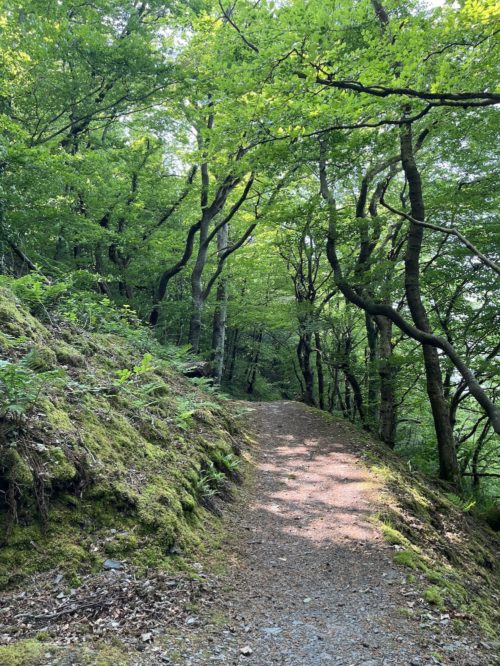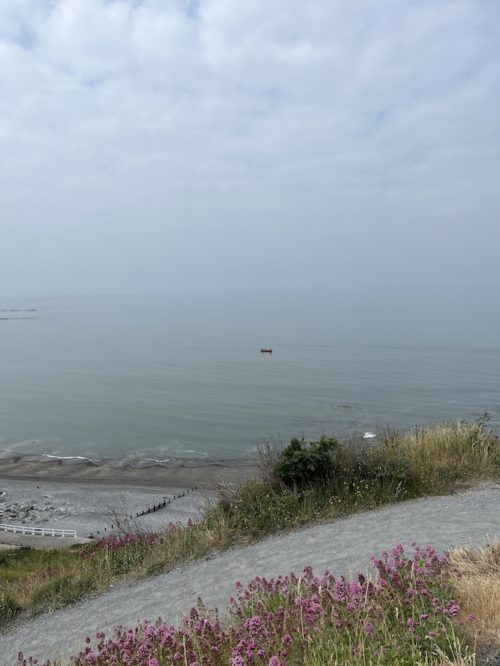Letter from Rhydyfelin

Morgan Owen
Before the rain
The vanguard of red campion holds its line, first flower to face us through the kitchen window as we waited for the first signs that the dull, cold spring would, in fact, give way.
They have since been overshadowed as the hedgerows have ignited with dogrose, honeysuckle and elderflower. It is summer, and the yearly ritual of incredulousness has been fulfilled, but there’s more concern than cliché in it this time.
I am unnerved by the irregularity of the seasons. The usual signposts are obscured or absent. Walking the coastal path, it is stark: bog to prairie in a matter of weeks.
Summer arrived like emissary from beyond the map: not believed until present, heart beating and eyes flaming.
But in the heat, the force of new growth is strong enough to draw us back into the seasonal bacchanal (though the dance is troubled by images of swathes of America and Canada bathed in an unworldly orange twilight, and this morning the charred, bittersweet smell of wildfire drifts from Coed Penglais, over Aberystwyth).
Pen Dinas has been bleached blonde, and so have most of the surrounding hills. But the beech trees at least seem undaunted. Coming back from Machynlleth recently, they arched over the road spilling green light, cathedrals of contortion and vital woodiness untypical of these parts of Ceredigion.
Though easily spotted on account of their smooth, greyish bark, it is the clear, airy forest floor they preside over that is most striking to me. Useful, too, in plotting out where to look for ceps and chanterelles when the when summer fades into autumn.

Spicy greenness
I am still new here, so most days have their discoveries. These have come primarily in the form of flowers and landscapes.
Along the cliffs the sea campion is now ragged, but the thrift is still going strong; musk mallow seems to be particularly at home on the roadsides.
In Llanbadarn churchyard I saw the strange fleshy flowers of ivy broomrape, a parasite of ivy which completely lacks chlorophyl, unplantlike and striking.
Our garden is bigger here, and correspondingly our horticultural ambitions.
Mid-March I sowed wormwood, probably too early, and had scraggly, sickly seedlings for a while, but now the nights are warmer my thinned out wormwood has thrust heavenward and taken on its characteristic glaucous shade.
Wormwood is often a relict of gardens, and lingers close to the hearth. It can be often be found on an otherwise bleak patch of waste ground, or even on the moors, and suggests the ghostly presence of an abandoned home.
There are certainly plenty of such ruins in Ceredigion, but I’ve grown my wormwood for their scent (between mint and sage, with a slightly spicy greenness) and their unusual foliage.
Living connection
In a damp corner the water avens – small suspended pinkish-crimson pompons – are starting to go over, just as the wild strawberries are ripening.
Our figs are faring well, recently joined by a White Marseilles, as is the vine: all conspire to produce a convincingly Mediterranean scene when the hot wind blows.
In a drier corner, our beans are likewise revived by the heat, having started strongly before declining as the temperatures clung to the departing winter.
We’ve planted among them two Welsh heirloom varieties: the District Nurse and the Rhondda Black, both from the Valleys, and therefore a living connection to home.
They have, however, been literally overshadowed by the peas, which have exploded upwards far beyond their supports, grasping about in the open air.
At night, the tawny owl calls out and what sounds like pacing in the front garden is a hedgehog forcefully rustling in the stillness.

Pseudo-prairie
My imagination often wanders to the prairie, and I’m not sure why exactly. I’ve never been there, nor to the steppes. But the dry hills about Rhydyfelin and the coastal path through Aberystwyth and Clarach to Borth have the same effect, currently.
Long golden grass waving in the wind and open vistas over harsh land. It isn’t entirely ridiculous. This is a pseudo-prairie with a psychedelic edge: up on the cliffs the sunsets are deep and all-pervasive with nothing to impede the horizon.
The sky glows and smoulders purple, and Pen Llŷn faces off from the north, solid and illusory in equal part, distorting distance.
In my work I often have to browse Welsh newspapers and periodicals from the nineteenth century, and when the colours leap out of the grasses and the sea I sometimes see in my mind’s eye, overlain on the landscape, the shadowy figures of itinerant preachers on their way to the far-flung boom towns that grew up around the mineral mines, a county seized by the turmoil of industry and revival.
Or maybe bandits from previous centuries setting out at dusk, unseen.
Out on the western shore, these histories feel alive and completely remote, and the ebb and flow of their substance matches the fickle wind.

After the rain
A hot mist had clung to the tops, sometimes coming down to the level of our garden.
The gasping earth needed soaking through, and at last the far-off thunder caught up with us and cleared the tension with a fierce downpour.
The world is diaphanously green and damp and the sky over the sea is now a pale, washed orange like a late dawn.
I am suddenly reminded of the two goldfinches that sat symmetrically each side of my path this morning, watching with interest as I passed.
Enjoy more ‘Letters from‘ by following the links on this map
Support our Nation today
For the price of a cup of coffee a month you can help us create an independent, not-for-profit, national news service for the people of Wales, by the people of Wales.




